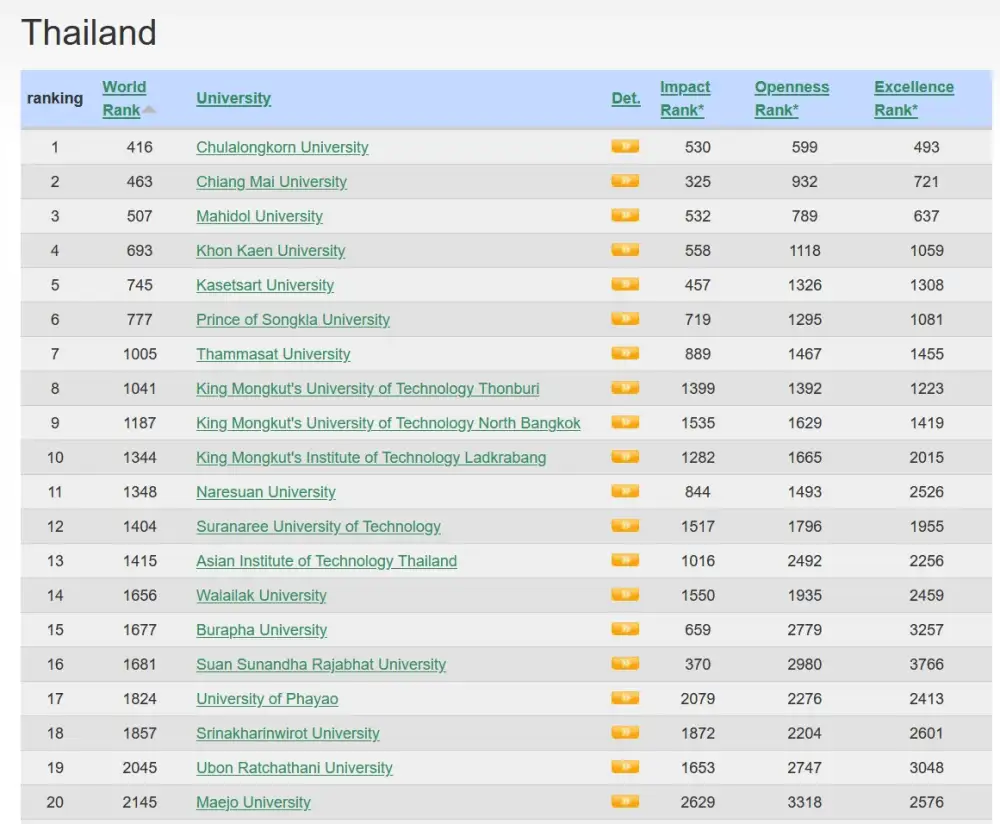
This ranking evaluates the quality of educational websites, including those of universities worldwide, based on their ability to disseminate open and free knowledge through the World Wide Web. The ranking was established in 2004 by the Higher Council for Scientific Research (CSIC) in Spain, with the aim of showcasing institutions that excel in sharing information and knowledge freely.
It uses three key indicators to determine rankings:
Accessibility through links from networks and other websites to the institution's website (Impact).
Citations of academic works on Google Scholar (Openness).
The number of academic works cited in the Scimago research database (Excellence).
The research conducted by the Ministry of Foreign Affairs of Thailand, in collaboration with the CSIC, focuses on three indicators:
Links to institutional websites accessed from the internet and other websites (Impact)
Google Scholar Academic Reference (Open)
The number of academic achievements cited in the Scimago (Excellence) research database.
Each indicator has its own unique data storage, score processing, and weight calculation processes. Webometrics relies on specialized software to analyze website performance, using databases from Google Search, Google Scholar, and Scimago. These results are then used to rank universities worldwide. Currently, there are 11,991 universities ranked globally, including 192 universities in Thailand. The University of Phayao was ranked in the first round of January 2024, with a total of two rounds per year.
In this round, the University of Phayao was ranked as follows:
- The 17th in Thailand.
- The 65th in Southeast Asia.
- The 617th in Asia.
- The 1824th in the world.
New evaluation criteria for Webometrics (First edition of 2023)
VISIBILITY (or IMPACT) This metric assesses the volume of data references and the number of external networks linking back to the university website. It considers the highest values from two data sources (Ahrefs and Majestic), with a weight of 50%.
TRANSPARENCY (or OPENNESS) It evaluates the number of citations from the top 310 authors (not including top 20 outliers), with a weight of 10%.
EXCELLENCE (or SCHOLAR) This metric considers the number of articles with citations in the top 10% in 27 subject areas based on the past five years (2018-2022), with a weight of 40%.
Network Metrology (First Edition 2020)
Visibility (or influence), like Webometrics, this metric assesses the reference quantity and the number of external networks linking back to the university website. It is based on the maximum value from two sources (Ahrefs and Majestic), with a weight of 50%.
Transparency (or openness) It evaluates the recommendations from the top 310 authors (excluding top 20 outliers), with a weight of 10%.
EXCELLENCE (or SCHOLAR) This metric assesses the highest number of articles cited in the top 10% in 27 disciplines over the past five years (2018-2022), with a weight of 40%."
